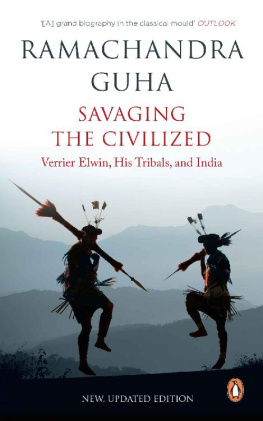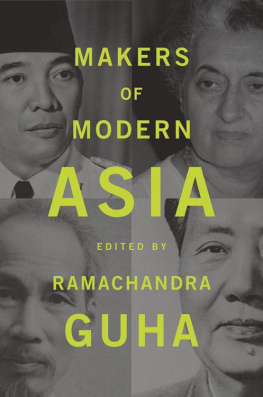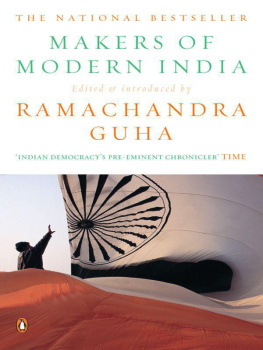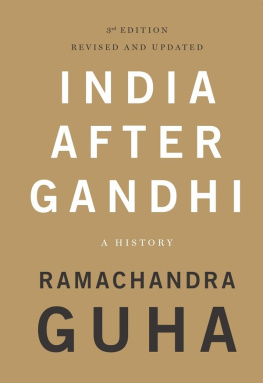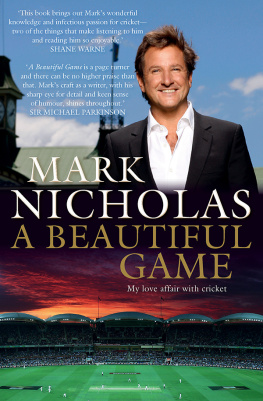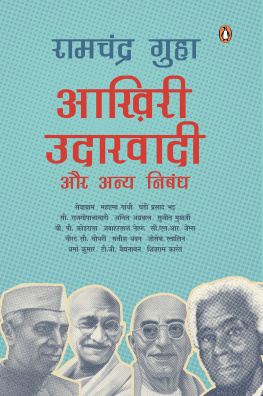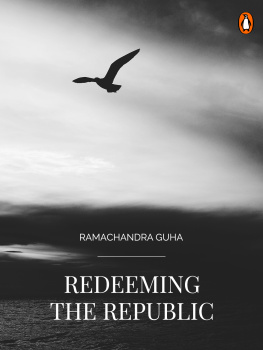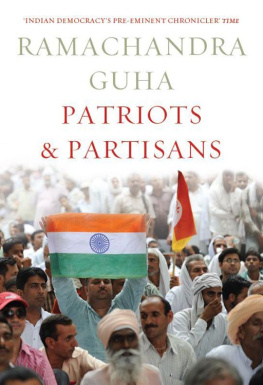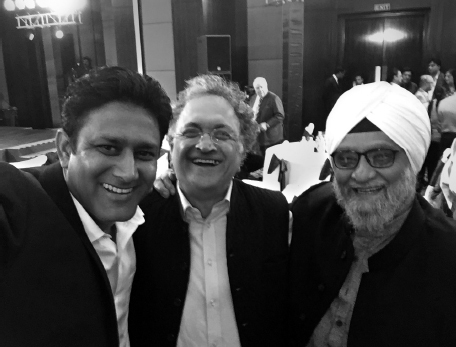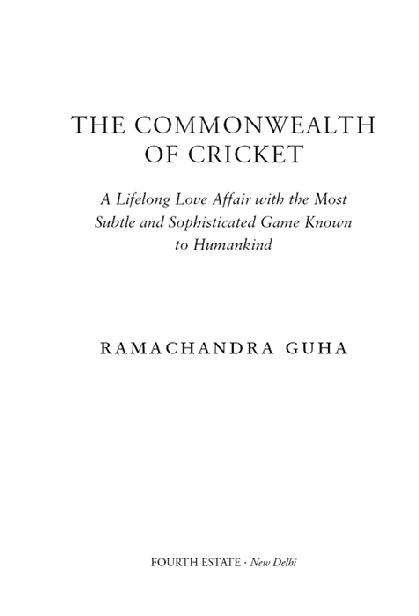I
I HAVE NO MEMORIES of the first cricket match I saw. Yet, I have heard so much about it since that I can write about it as if I did. The match was played in the cricket ground of the Indian Forest College (IFC) in Dehradun. The field was ringed to the south and the west by stately old beech trees. To the east were rows of probationers hostels, built in red brick. On the grounds northern side ran a road, beyond which were officers bungalows built in the style of Lutyens Delhi. If one bowled or umpired from the southern end (as I often did in later years) one had a magnificent view of the Mussoorie Hills rising to seven thousand feet and beyond.
Dehradun is now the capital of the state of Uttarakhand, and has a million and more residents. When I was born, in 1958, it was a small district town in Uttar Pradesh, notable for its beauty. It was set in a long, low valley, with the Sivalik Hills to its south and the Himalaya to its north. Its western border was defined by the Yamuna River; its eastern border by the Ganga, which the Yamuna eventually joined, several hundred miles into the plains. The district had large tracts of sal forests, rich in animal and bird life, interspersed with paddy fields and litchi orchards and a whole clutch of government institutions. These included the Survey of India, the Indian Military Academy, and the Forest Research Institute (FRI).
At the time I saw my first cricket match, my father was a scientist at the FRI, of which the Indian Forest College (IFC) was a part. My maternal grandfather also worked at the FRI. His sonmy mothers brotherwas a legendary local cricketer named N. Duraiswami. When Durai was about tenand himself watching cricket matches at the IFC groundhe fell from a wall and fractured his right arm. The doctor, who was incompetent or drunk, or perhaps both, set the plaster so tightly that Durai lost circulation in his main arm. For ever afterwards it hung limply from his body. He could use it to shake hands, but for little else.
My grandfather was the leading wood scientist in India. Unlike his father Durai was an academic duffer, but a terrific sportsman. He played football, hockey, tennis and squash to a decent level. But the game he loved most was cricket. After his accident, Durai taught himself to bowl with his left hand, becoming an artful finger-spinner. He was a useful lower-order batsman, andeven with only one good arma superb fieldsman.
The first cricket match I watched was played in 1962, when I was four. It was the annual derby between the probationers of the Indian Forest College and the staff of the Forest Research Institute. The captain of the FRI team was my uncle Durai, eligible to play as the son of an officer. Durai had just then completed three years at St. Stephens College in Delhi, where his cricketing mates included K.S. Indrajitsinhji, later to keep wickets for India, as well as Prem Bhatia, Ramesh Dewan and Bharat Awasthy, all to enjoy long and successful Ranji Trophy careers. In the 196162 college cricket season, Durai had taken the most wickets for his team. The season ended with the final of the inter-college championship, in which St. Stephens played the universitys law college. Laws team included Manmohan Sood, who had just played his first (and it turned out, last) Test match, as well as Hanumant Singh, an elegant right-handed batsman then making loads of runs in first-class cricket and who a few years thereafter was to score a hundred on his Test debut. The turning point of this inter-college final was when Durai, fielding at deep mid-wicket, caught Manmohan Sood with the one good hand he had.
Delhi was the capital of India, while Dehradun was, in cricketing as much as political terms, a backwater. Durai was well known and widely admired in the towns sporting circles: for what he had done with one arm, and for having so recently played alongside some of the finest young cricketers in the country. (That he was incredibly handsome also helped.)
In the summer of 1962, Durai was sent down from St. Stephens for failing his final examinations. But honour at home could still be redeemed on the cricket field. In November of that year he played a critical part in Dehradun winning, for the first time, the inter-district championship of Indias largest state, Uttar Pradesh. With a lanky fast bowler named Jindo, Durai took all the wickets, and with a burly opening batsman named Sheel Vohra, Durai scored all the runs, as Dehradun defeated the fancied teams of Meerut, Aligarh and Lucknow districts.
In December 1962, my grandfather turned fifty-eight, the age at which government servants then retired. At the end of the month, and year, he would move from Dehradun to the southern city of Bangalore to start a new research institute, funded by the plywood industry. Durai still had one cricket match to play in our hometown, for the FRI against the IFC. While my uncle captained the FRI, the IFC was led by a fast bowler named Prasad, who had already played Ranji Trophy for his home state (Madhya Pradesh as I recall) before coming to Dehradun as a probationer of the Indian Forest Service.
Playing alongside Durai for the FRI in the first cricket match I watched was my father, Dr Subramaniam Rama Das Guha. He was the captains last choice, picked ahead of a promising young fast bowler named Manoj Sharma, the son of the Institutes photographer. The decision was controversial. In past years Dr Guha had used the long handle to good effect, but he was now pushing forty, and a liability in the field. Did Durai pick him ahead of Manoj Sharma because he thought he needed more depth in batting? Or because Dr Guha was his brother-in-law?
It was a glorious winters day in the foothills, crisp and cloudless. I watched from the tiled wooden pavilion beyond mid-wicket, while Durai won the toss, and chose to field. He took six wickets as the IFC were bowled out for 132, in small-town cricket not an insubstantial score. Half of Durais victims were stumped, dragged out of the crease by his curving, alluring flight, the bails adroitly removed by the wicketkeeper, Ram Nath Gideon, the FRIs medical officer, who had once hunted in the forests of Kumaun with the famous slayer of man-eating tigers, Jim Corbett.
When FRI went into bat, the IFCs Prasad made quick inroads with the new ball. Durai, coming in at number fourmuch higher than he batted for St. Stephenssteadied the ship. While wickets fell around him he marched on, with clips to leg and the odd cover drive. He reached 50, and the innings crossed 100. Twenty to win, then 10, and now only 5. With FRIs score at 130 for eight, Durai pushed forward to the IFCs off-spinner. The ball went through with the arm, and took the outside edge of his bat, to be taken safely at slip.
The last man in was Dr S.R.D. Guha, on weekdays the officer-in-charge of the cellulose and paper branch. He knew how to experiment with chemicals on different kinds of wood and bamboo, and had published dozens of scientific papers. But could he win a cricket match?



